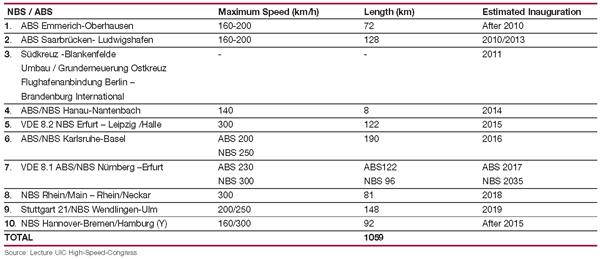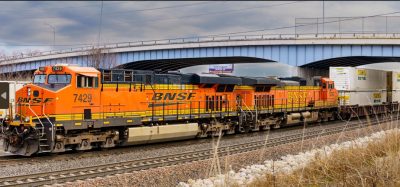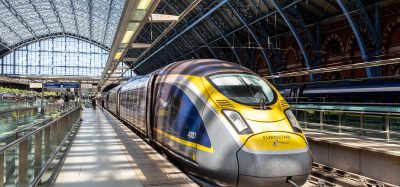DB to add 1,000km to the high-speed network
Posted: 28 May 2008 | | No comments yet
In a recent presentation from Dipl.-Ing. Wolfgang Feldwisch of DB Netz AG given at the UIC High-Speed show in Amsterdam, ambitious plans for enlarging the German high-speed network were explained.
In a recent presentation from Dipl.-Ing. Wolfgang Feldwisch of DB Netz AG given at the UIC High-Speed show in Amsterdam, ambitious plans for enlarging the German high-speed network were explained.
In a recent presentation from Dipl.-Ing. Wolfgang Feldwisch of DB Netz AG given at the UIC High-Speed show in Amsterdam, ambitious plans for enlarging the German high-speed network were explained.
The first German high-speed rail lines were planned in the 1980s, when the Iron Curtain dividing the country was still in place.
Historically, the main transport corridors in Germany had been east-west routes centred on Berlin. With the division of the country, West Germany needed better north-south links. Accordingly, the first high-speed lines ran north-south, from Hannover to Würzburg and Mannheim to Stuttgart. These pioneer routes, opened in 1991, and have maximum speeds of up to 280km/h.
Since 2002, DB Netz AG has had a line capable of 300km/h. The new line from Frankfurt to Köln climbs up over the hills and bypasses the scenic but curvaceous historic route alongside the river Rhine, with 300km/h ICEs cutting journey times between the two cities.
Eastern Germany
With the reunification of the country, there was a need to upgrade the east-west routes feeding into the former East Germany. The Hannover-Berlin line was upgraded in the 1990s for a top speed of up to 250km/h, while the route from Hamburg to Berlin was completed with a maximum speed of 230km/h in December 2004.
With Berlin once again the German capital, the city became the focal point for services running to all corners of the country. To accommodate these long-distance services, as well as enhanced regional and S-Bahn services, a new multi-level station costing €3.9 billion was built on vacant ground in the former No Man’s Land dividing the city, close to the iconic parliament building and other new federal government buildings. The main east-west route across the city runs on the top level, and new north-south link lines have been built to serve lower-level platforms.
The new Berlin Hauptbahnhof was ready in time for the summer of 2006, when Germany played host to the European football championships and was inundated with foreign visitors. Also completed in time for the championships was the upgrading to 200km/h of the historic line running for 187km from Berlin to Halle and Leipzig, along with another 300km/h new line in the south of the country, running for 82km from Nuremberg to Ingolstadt (and then for a further 89km on to Munich on a line upgraded for 200km/h).
Meanwhile, to the west of Germany, the Belgians have been busy constructing a new high-speed line running east from Brussels. We have upgraded the line from Aachen to the border to connect with this, including construction of a large new tunnel, the Buschtunnel.
Large network
Germany has been building high-speed railway lines for more than two decades now, and by the beginning of 2008, the network of new (NBS) and upgraded (ABS) high-speed lines extended to 1,334km.
However, DB Netz AG are not stopping there. DB Netz has plans to add more than 1,000 km to the high-speed network by 2020. This massive programme will cost an estimated €18 billion for the infrastructure alone whilst new rolling stock to run on the new lines will be at extra costs.
Table 1 shows the principal projects planned for this 12-year programme.


Table 1: New (NBS) and upgraded (ABS) high-speed lines planned in Germany. Status numbers 4, 8, 9 and 10 are being planned, all otheres are under construction
Feats of engineering
The proposed line from Ludwigshafen to Saarbrücken is interesting as it links into the Paris-Ost Frankreich-Sud-Deutschland (POS) project. A key element of this is the replacement of the bridge over the Rhine, linking Saarbrücken to Strasbourg in France. The new bridge is due to be in place by the end of 2010, and the whole line to Ludwigshafen should be ready by the end of 2013.
The Karlsruhe-Basel project combines upgrading of the historic route along the Rhine, where top speeds will be 200km/h, along with tunnelling through some hills to avoid sinuous loops on the river. The new stretches will have a maximum speed of 250km/h. The most ambitious part of the project is the Katzenberg tunnel, on the approach to Basel, which is due to be finished by the end of 2011. The whole line should be ready in December 2016.
Viaducts and bridges will be the main features of the Erfurt – Leipzig / Halle line. The 122km total length of the line will include 14.4km on six viaducts. There will be three tunnels, comprising 15.4km in length. When it opens in December 2015, the new route will cut 46 minutes from the journey time between Erfurt and Halle.
The route from Nürnberg to Erfurt has to cross a range of hills, with some impressive tunnels. An early beneficiary of this project will be Nürnberg itself, where S-Bahn operations on an upgraded stretch of line will begin in 2010. The 122km stretch of new line running south from Erfurt through the hills is due to be ready in 2017.
The 81km Rhein/Main – Rhein/Neckar project will cut 16 minutes from the journey time from Mannheim to Frankfurt when it opens in 2018. The new line will bypass Darmstadt, although junctions are planned on the new line to allow some trains to access the town by way of the historic line.
Tunnels are a feature of the Stuttgart-Ulm-Augsburg project, which avoids some built-up areas on the south side of Stuttgart by going underground. The section at the northern end of the line comprises part of the Stuttgart 21 project, and 33km out of this 57km stretch will be in 16 tunnels. There will be gradients of up to 3.1% on the 91km stretch south of Stuttgart.
Investment for the future
The Deutsche Bahn high-speed network will be extended by approximately 1,060km over the next 12 years. This programme is a major prerequisite for the success of DB AG and for the ongoing integration of the European high-speed rail network.








